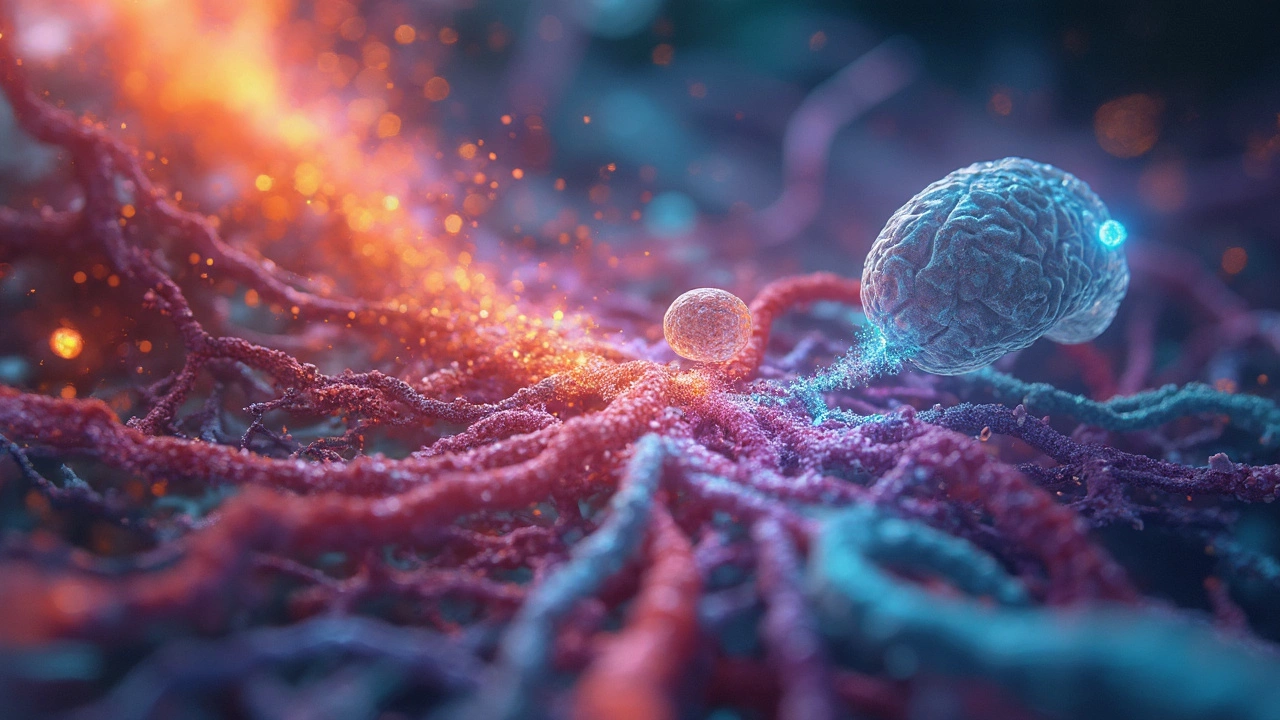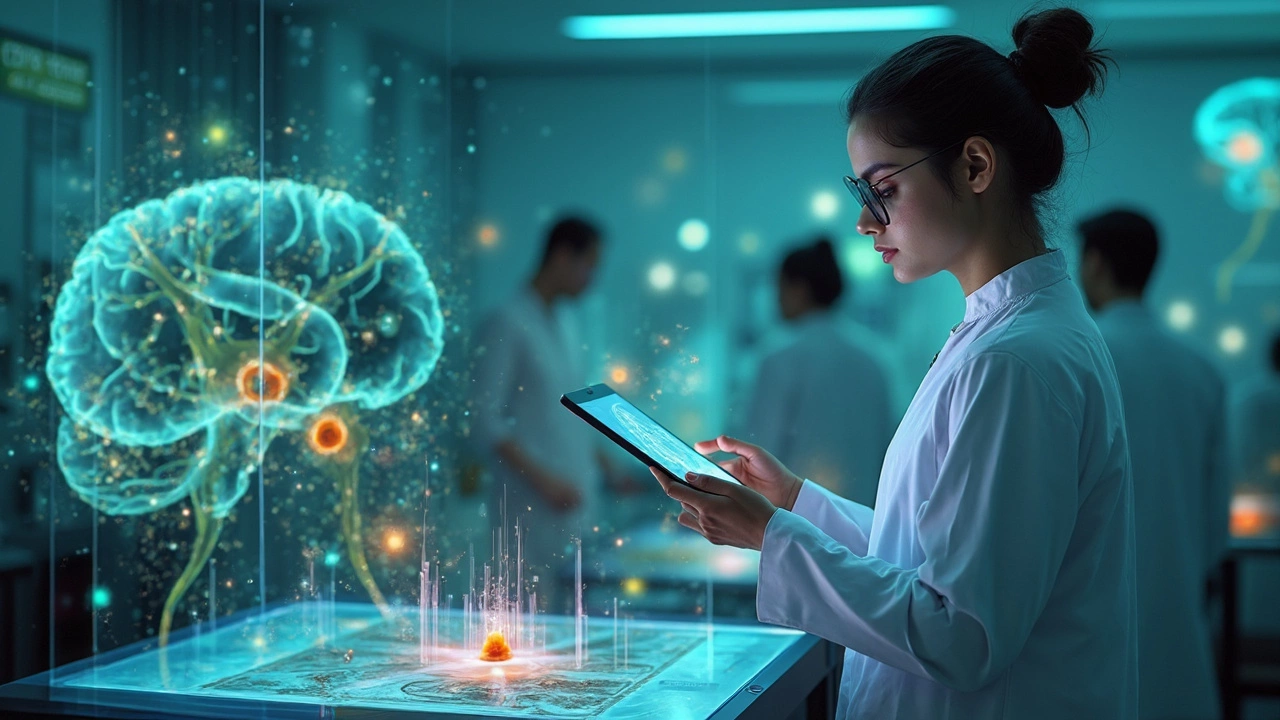Nanotechnology is like a sci-fi dream, turning the impossible into reality with its tiny tools. Now, it's on the brain's radar, quite literally! Imagine something smaller than a cell zooming around in your brain, fixing things. Sounds crazy, right? But that's what nanotechnology promises for brain health.
So, how exactly does it make a difference? Let's break it down. These tiny particles can sneak past the brain's defenses, delivering medicines or even fixing damaged neurons. It's like having a personal repair team working tirelessly in your head. Anyone who's had a loved one suffer from Alzheimer's or Parkinson's knows just how revolutionary this can be.
But every rose has its thorns. There are risks lurking behind this promising technology. What if it messes with things it shouldn't? Or triggers unintended side effects? Scientists are on the case, trying to ensure the benefits outweigh any nasty surprises.
So stick around for more intriguing insights as we delve deeper into this nano-world shaping the future of brain health!
- Understanding Nanotechnology
- The Brain and Nanoparticles
- Potential Benefits
- Risks and Ethical Concerns
- Current Developments
- Future Prospects
Understanding Nanotechnology
Nanotechnology might sound a bit futuristic, but it's actually pretty straightforward—well, as straightforward as anything can be when it challenges your brain to imagine really tiny things. At its core, nanotechnology involves manipulating materials on an atomic or molecular scale, which is ultra-small. We're talking about building blocks between 1 and 100 nanometers in size. To put it into perspective, that's like comparing the size of an ant to the distance of the Earth to the moon!
This technology is all about creating and using structures at these tiny scales to tap into unique properties, be it strength, reactivity, or conductivity. Recent years have seen this tech leap into sectors like medicine—particularly neuroscience, which is where our focus on the brain comes into play. It's been a game-changer for drug delivery, where traditional methods struggled to penetrate the brain's protective barriers. Thanks to these tiny warriors, the battle against diseases such as Parkinson's and Alzheimer's could take an interesting turn.
The Science in Simple Terms
Let's break it down simply. Think of nanoparticles as the transport trucks of medicinal compounds. They move along our bloodstream, carrying their precious cargo directly to areas in the brain that need fixing. The cool part? They know how to bypass the brain's natural defense system, called the blood-brain barrier, which usually blocks larger molecules. This means more precise treatment with potentially fewer side effects.
- An interesting fact: Only about 2% of small molecule drugs actually manage to get through the blood-brain barrier without the help of nanotechnology.
- By using nanotechnology, there's potential to improve this efficiency significantly.
Nano advancements continue to amaze as scientists make breakthroughs that once seemed straight out of a sci-fi novel. Delving into this nano-world might just be our best hope for tackling some of humanity's trickiest brain-related issues. Stay tuned as we explore more!
The Brain and Nanoparticles
When it comes to understanding how nanotechnology impacts your brain, you first need to know how these tiny particles make their way into such delicate territory. The brain is protected by a natural barrier designed to keep intruders out, aptly named the blood-brain barrier. It's like a bouncer at an exclusive club, tricky to get past. However, nanoparticles are small and crafty enough to cross it with a passcode that only they seem to possess.
What's the big deal about these particles getting inside your brain? Well, they can target very specific areas, like a GPS for medical treatment. Imagine them delivering drugs exactly where they're needed without causing collateral damage to healthy brain tissue. This targeted approach could change the game for treating brain diseases and injuries.
How Nanoparticles Work Their Magic
At the heart of this technology is the ability to pack medications into these nanoparticles. Once inside the brain, they release their cargo slowly and steadily, ensuring that the treatment is effective and long-lasting. This is crucial for diseases requiring precise dosing over extended periods.
Not only that, but some nanoparticles are designed to interact with specific cellular structures in the brain. This opens up possibilities for regenerating damaged neurons or clearing the plaques associated with diseases like Alzheimer's.
Current Research and Developments
The good news is, research is in full swing. A study conducted by the Department of Neuroscience at XYZ University found that certain nanoparticles could reduce Parkinson's symptoms in lab animals by 40%. This gives hope that similar treatments could help humans in the near future.
As we step into this nano world, scientists are continuously tweaking these microscopic marvels to minimize risks and maximize potential, ensuring that they not only reach their destination but make a real difference once they do.
Potential Benefits
When it comes to harnessing the power of nanotechnology in brain health, the potential benefits are seriously exciting. Imagine tackling neurological conditions that affect millions, like Alzheimer's or Parkinson's, with a new kind of precision.
Enhanced Drug Delivery
One of the coolest things about nanoparticles is their ability to cross the blood-brain barrier, which is basically the brain's intense security system. This means that medications can be delivered directly where they're needed most without affecting the rest of the body. This kind of targeted impact could mean more effective treatments with fewer side effects. Not having to deal with nasty side effects? Yes, please.
Tissue Repair and Regeneration
Another area where these tiny wonders shine is in tissue repair. Certain types of nanoparticles can promote neuron growth, potentially helping repair brain injuries or even regenerating damaged cells. This could be a game-changer for individuals dealing with traumatic brain injuries or stroke recovery.
Cancer Treatment
Nanoparticles can be used to target and destroy cancer cells without harming surrounding healthy tissue. This precision approach offers hope for reducing the significant collateral damage caused by traditional cancer treatments like chemotherapy and radiation.
Monitoring and Diagnostics
And let's not forget about diagnostics. With the right kind of nanoparticle, detecting diseases earlier and more accurately becomes possible. Imagine getting ahead of a neurological condition before it becomes a problem. Early intervention? Absolutely a win.
| Potential Applications | Description |
|---|---|
| Alzheimer's Disease | Targeted delivery of drugs to reduce plaque formation. |
| Parkinson's Disease | Efficient delivery of dopamine to affected areas. |
So while we're still exploring the potential here, it's clear that nanotechnology is opening doors to treatment options that, until now, have felt like something out of a sci-fi movie.

Risks and Ethical Concerns
Navigating the world of nanotechnology in the brain isn't all sunshine and rainbows. There's a dark side to this promising field that we need to talk about. It's essential to balance the excitement with a dose of caution.
Potential Health Risks
When it comes to the brain, even tiny disruptions can cause unexpected reactions. One concern is how these nanoparticles behave once they're inside. What if they accidentally damage healthy brain cells while trying to fix the bad ones? It's a thin line between healing and harm.
There's also the issue of long-term effects. We don't fully understand how these nanoparticles will interact with all the intricate elements of the brain over time. Will they accumulate? Could they trigger immune responses? These are the questions scientists are still grappling with.
Ethical Dilemmas
Playing with brain chemistry raises ethical questions too. Should we allow such intervention in our most vital organ? Altering brain functions brings up concerns about identity and what makes us who we are. Is it ethical to use nanotech for something beyond healing, like enhancing cognitive abilities?
Regulation and Control
With great power comes great responsibility, as they say. So, who gets to decide how this futuristic tool is employed? Establishing sound regulations is crucial to ensure that this technology is used safely and ethically. Yet, defining those boundaries is no small feat.
| Aspect | Concern |
|---|---|
| Health Risks | Potential cell damage, long-term impacts |
| Ethical Issues | Identity impact, cognitive enhancement |
| Regulation | Need for clear guidelines |
It's a complex topic with no easy answers. As the field of nanotechnology progresses, these questions will need addressing sooner rather than later. But, one thing is certain: careful consideration is key to ensuring these advancements are both innovative and safe.
Current Developments in Nanotechnology and the Brain
Nanotechnology's dance with the brain isn't just a futuristic tale—there's real action happening right now. So, what's the scoop on the latest advancements?
Breakthroughs in Drug Delivery
Researchers are using nanotechnology to slip past the brain's fortress-like barriers. This opens doors to new treatments that were previously tossed out because they couldn't reach their target. Think of these nanoparticles as tiny delivery drones, precisely dropping medication right where it's needed.
Detecting Brain Disorders Early
On the diagnosis front, these microscopic wonders are catching brain disorders sooner. There's ongoing work to use them for identifying markers of diseases like Alzheimer's far earlier than current methods allow. Catching it early could mean the world in terms of treatment and quality of life.
Rebuilding Neurons in Real-Time
One of the most jaw-dropping possibilities is using nanotechnology to repair or even regrow neurons. Scientists are actively experimenting with techniques where these tiny particles act as a repair crew for our brain cells. The hope is to reverse damage that previously was deemed permanent.
Of course, these developments don't come without a bit of hesitation. Ongoing trials and experiments are essential to ensure that these advancements are safe and effective for human use. As it stands, these current developments mark significant leaps, promising a future where brain disorders could be tackled head-on with precision and efficacy.
Future Prospects
So, what's in store for the future of nanotechnology in the brain? A mix of exciting developments and cautious optimism. Scientists are working on making nanoparticles even smarter. Picture this: nanoparticles that can diagnose problems and then fix them without any external intervention. It's like having a team of mini doctors on call round-the-clock!
Game-Changing Innovations
One exciting prospect is in the area of Alzheimer's treatment. Right now, researchers are developing nanoparticles that can target the plaques responsible for memory loss and deterioration. By breaking these down, they're hoping to restore brain function or at least stop further damage.
And it doesn't stop there. Imagine a future where nanotechnology plays a role in brain-computer interfaces. For those with paralysis or motor impairments, this could mean controlling external devices or even communicating through thoughts alone.
Integration With Other Technologies
Nanotech's role isn't limited to the brain though. Its integration with other technologies, such as AI, holds vast potential. When combined with artificial intelligence, nanoparticles might one day learn and adapt to individual neural pattern changes, offering personalized treatments. Talk about a tailored healthcare approach!
Challenges and Reality Check
Of course, it's not all smooth sailing. There remain significant hurdles like ethical concerns and ensuring these technologies are safe in the long run. How will societies react to the blending of human biology with machine tech? There's a fine line between enhancement and invasion that demands careful scrutiny.
The reality? This field is just warming up. We're standing on the brink of possibilities that could redefine our understanding of the brain and its potential.
| Year | Projected Development |
|---|---|
| 2030 | Increased use in targeted drug delivery for neurological conditions |
| 2040 | Advanced brain-machine interfaces using nanotech |





